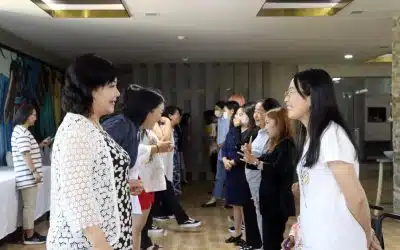InAsia
Insights and Analysis
World Economic Forum Ranks Philippines Best in Asia on Gender Equity
October 20, 2010
In its Global Gender Gap 2010 Report, released last week, the World Economic Forum ranked the Philippines 9th among nearly 200 countries in gender equity. The Philippines is also Asia’s highest-ranking country (followed by Sri Lanka at 16, and Mongolia at 27). It ranks 1st on both education and health among Asian countries, and boasts very strong performances overall on economic participation (13th) and political empowerment (17th).

The Philippines ranks as Asia's best country on gender quality, illustrating the great strides Filipino women have made in society. But serious discrimination, such as workplace harassment and human trafficking remains.
The Philippines is the only country in Asia this year to have closed the gender gap on both education and health – it’s in the company of only eight countries in the world to have done so.
This good news comes amidst the current debate over the passage of the Reproductive Health Bill in the Philippines, which has languished in oblivion in several Congresses because of the staunch opposition of the very influential Catholic Church, but has been thrust into the limelight again after President “Noynoy” Aquino recently declared reproductive health a major priority of his.
The report measures male-female equality in the areas of politics, education, employment, and health to capture the magnitude and scope of gender-based disparities and track their progress. The rankings are designed to create greater global awareness of the challenges that men and women face as a result of such disparities. The report maintains that low gender gaps correlate directly with high economic competitiveness, and concludes that, if a country is to grow and prosper, women and men must be treated equally.
In terms of the Philippines, this high ranking helps illustrate the great strides Filipino women have made in society: they have a longer lifespan than men; more women than men are enrolled in colleges and universities; many more women hold CEO positions than before in top corporations and in previously male-dominated positions like law, medicine, and engineering; more women are registered to vote than men; and women make up a higher percentage in Congress than ever before. Having had two women presidents (a total of 16 years in the last 50 years) has contributed significantly to lessening the gap between men and women in terms of political participation. However, this indicator needs to be qualified, as counting the number of years a woman was in the presidency is too simple if the president was unpopular and implemented policies that were not empowering to women.
The strides made highlight the extraordinary tasks and responsibilities that Filipino women have taken upon themselves in the past decade. Filipino women are survivors. More than anything else, they have undertaken exceptional measures for their families’ economic survival. For example, the majority of overseas Filipino workers, accounting for 9 million, or 10 percent, of the entire population, are women. Through the hard-earned remittances that they send home, they contribute to about 10 percent of the country’s gross domestic product. This much-needed income has provided food on their families’ tables and much-needed appliances, built stone houses in rural countrysides, sent children to school, and paid for hospital bills and healthcare. Back home, women’s significant role in the informal sector, known here as the “underground economy,” has contributed greatly to the nation’s economy. By default, women have assumed the breadwinner role when the men are not able to land sufficient jobs.
Although this report does not capture differences between the participation of women and men at the local level, a study conducted by Prosperina D. Tapales, professor of public administration at the University of the Philippines in Diliman, confirmed more recently by March 2010 statistics from the National Statistical Coordination Board, indicate that women are increasingly present at the local levels as well. However, the lessening of the gender gap at the local levels of government could be attributed to the survival instincts of political dynasties and political pragmatism. For instance, when their term limits are set to expire, male politicians “pass on” the positions to their female relatives – wives, sisters, daughters – in order to maintain their hold on power. Most often, male politicians serve as the “advisers” of the female politicians. In national and local elections in May, political dynasties continued to reign, with women politicians put in place to serve as substitute candidates for their menfolk.
Despite these glowing figures, women in the Philippines still face serious discrimination, including workplace harassment and abuse. Women who voice their concerns and rights are often ignored, while a macho culture prevails. The phenomenon of overseas contract work should be accompanied by safer migration and better policies to prevent human trafficking and slavery-like working conditions. More importantly, the Philippine government should work doubly hard in providing employment for its citizens so that they need not be forced to migrate for work. Stronger, more empowered families – spared the psychosocial problems resulting from single-headed households or absentee parents – is what the Philippines needs to truly close the gender gap.
Maribel Buenaobra is The Asia Foundation’s director of Gender and Elections programs. She can be reached at [email protected].
About our blog, InAsia
InAsia is posted and distributed every other Wednesday evening, Pacific Time. If you have any questions, please send an email to [email protected].
Contact
For questions about InAsia, or for our cross-post and re-use policy, please send an email to [email protected].The Asia Foundation
465 California St., 9th Floor
San Francisco, CA 94104
The Latest Across Asia
Program Snapshot
April 18, 2024
News
April 17, 2024

2024 Lotus Leadership Awards
Thursday, April 25, 2024, New York City
The Lotus Leadership Awards recognize contributions towards gender equality in Asia and the Pacific







0 Comments